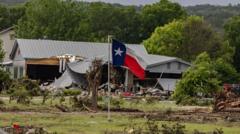Following devastating floods in Texas, the effects of staffing cuts at the National Weather Service (NWS) have come under scrutiny. While some experts argue that cuts may have hindered local coordination, others maintain that forecasts were adequate for the situation.
Did Staffing Cuts Impede Weather Predictions During Texas Floods?

Did Staffing Cuts Impede Weather Predictions During Texas Floods?
Experts examine if reductions in National Weather Service personnel impacted forecasts amid tragic flooding events in Texas.
In the wake of the catastrophic floods in Texas, discussions have arisen regarding the implications of workforce reductions at the National Weather Service (NWS), stemming from budget cuts during the Trump administration. Senator Chris Murphy emphasized the vital role of accurate weather forecasting in averting tragic disasters, suggesting that ongoing cuts may have weakened the NWS's capacity to effectively warn against such disasters.
However, White House Press Secretary Karoline Leavitt countered this narrative, asserting that NWS offices were adequately staffed during the Texas floods, calling claims to the contrary "completely false." BBC Verify has closely examined the staffing levels in light of prior budget cuts, and while a reduction in personnel has occurred within the NWS, experts indicate that the staffing available during this event was largely sufficient.
The Trump administration had proposed a notable 25% budget cut to the National Oceanic and Atmospheric Administration (NOAA), which oversees the NWS, slated to take effect in the 2026 fiscal year. Therefore, these proposed cuts would not have had direct consequences on the recent flooding in Texas. Nevertheless, intentional efficiency measures since January led to significant staffing losses at the NWS—about 600 from a workforce of 4,200. Reports indicated some offices had vacancy rates as high as 20%—double that of a decade ago.
Despite these reductions, experts assert that NWS forecasts and flood warnings issued during the Texas flooding were consistent with expectations. Avantika Gori, a civil and environmental engineering professor at Rice University, noted the challenges posed by extreme localized rainfall, suggesting that the difficulty in forecasting such conditions was a primary obstacle.
Nonetheless, there are concerns that staffing shortages may have disrupted effective communication between local NWS offices and emergency management resources. Climate scientist Daniel Swain remarked on the importance of maintaining personnel capable of optimal communication regarding weather information. Some local offices, such as those in San Antonio and San Angelo, experienced existing vacancies, including critical positions like meteorologists and hydrologists.
In anticipation of the floods, the NWS had temporarily increased staffing in the affected areas, according to spokeswoman Erica Grow Cei, stating that all forecasts and warnings were issued in a timely fashion. Meteorologist Jason Runyen confirmed an increased number of forecasters on duty during the emergency compared to standard operations.
The question of how budget cuts affected weather data collection surfaced, particularly regarding weather balloon launches, key tools that gather crucial atmospheric data. It's noted that plans to limit launches in several locations have emerged as a result of staffing issues. However, weather balloon data was still successfully collected at Del Rio, the nearest launch station to the flood zones, corroborating that adequate data informed meteorological forecasts leading up to the tragic floods.
As communities continue to recover from the Texas flooding, discussions about the role of government budget cuts within emergency management and disaster preparedness persist, with varied opinions about their impact on recent events.






















